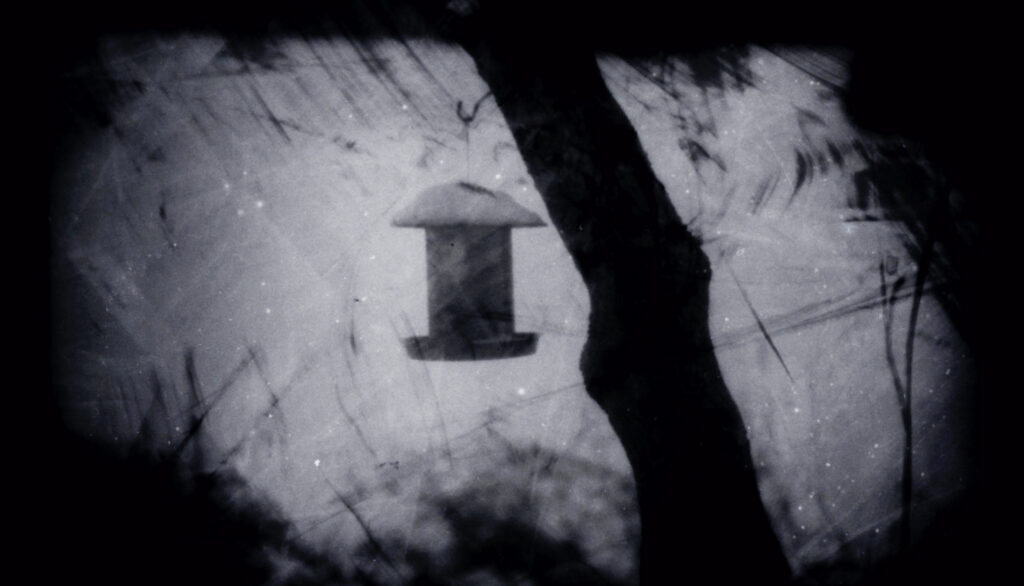
Deep 1 (14:30, 2023)
Filmed over 2 years (2020-2022), at home and away, Deep 1 is a diaristic meditation, flower/plant processed and decayed with hyacinth and lichen extract. Winged and four legged animals, both wild and domestic, traverse the frame marked by a hand-made practice. Filmed in Mount Forest, Ontario and Dawson City, Yukon. *available on digital & on 35mm
Analogica Festival, Bolzano, Italy 2024 Playhouse Theatre, Hamilton, Ontario 2024 Prismatic Ground Film Festival New York 2024 Shapeshifter Cinema, Oakland 2024 Simon Fraser University, Vancouver 2024 Adhoc, Innis College Toronto, 2024 Revolutions Per Minute Film Festival, Harvard U, Boston 2024 Ann Arbor Film Festival 2023, USA; Jury Award Ribalta Experimental Film Festival 2023, Italy La Escuela Internacional de Cine y Televisión (EICTV) 2023, Cuba Strangloscope Festival, Brasil 2023 16mm Film Festival, Mumbai, India 2023
Opening audio passage from a recording of the “Gayatri Mantra” by mentor/friend Rup Chand (Ann Arbor 1979). He told me that his mother suggested he recite the words when he was in fear.
Om Bhur bhuvah svah Tat savitur varenyam Bhargo Devasya dheemahi Dheeyo yonah prachodayaat — The Rigveda (10:16:3)
“Oh manifest and unmanifest, wave and ray of breath, red lotus of insight, transfix us from eye to navel to throat, under canopy of stars spring from soil in an unbroken arc of light that we might immerse ourselves until lit from within like the sun itself.” (translation from Sanskrit by Ravi Shankar)
About looking at things; envisioning a space “where we are not separated from other things.” – R.H. Blyth

“across the window, birds and beasts look unaware of their decay” –Ph
Still Time in Philip Hoffman’s `Deep 1’
by Lucia Ruggieri, Francesco D’Accia, Matteo Ricci (Ribalta Experimental Film Festival, Italy)
Thankyou Federica Foglia for the Italian to English translation!
The Gāyatrī mantra of the Ṛgveda sets-up the entire short film: it is the mantra itself that creates the atmosphere of darkness, followed by the first creation: the tree, which contains the identity of darkness as if it were its visible matter.
Forms move within this matter, but this movement of time is related to another time: what gets captured initially is the object, the animal, the horse – but these cease to exist and the gaze focuses on the background, on the tree, on the “still”. This trick allows us to understand the internal movement of still time: the horse is not slow in its own time, but it is slow in still time.
The juxtaposition between sensation of elements such as the tree (which we associate with a state of stillness) and elements such as the bird or the horse (which we associate with movement) makes it possible to think of a still time in which the passing of it is not felt. The view point is that of man, not that of frozen time.

The final subject is still time, upon which the whole is built upon. One can recognize and experience moving time properly because it is juxtaposed to still time: the observer is standing on a bridge between the still time and the observational time, so that from a still viewpoint one can perceive the process of the internal movement that leads to creation. This creation happens throughout the whole film, via a process of decomposition, desegregation, not only on the actual film, but in the shape itself. An experiment of form and movement that forces us to better define what is the still time in which all of the events happen.
Still time is not that of the “Absolute”. On one end there is a progression, that from the absolute proceeds to heavenly spheres in which time is spiritual; furthermore, on the other end, there is a pre-condition of material time from which a series of indistinct which by distillation creates/produces individual time. This pre-condition – the perceived still time – is nonetheless material, like the shapeless material constituted by the darkness of still time. The shapes/forms presented are a sketch, not yet the final product, these shapes/forms are not those of the defined material, fully materialized through which one usually perceives moving time. And is not an optical perception in a moment of aesthetic contemplation. The perception of still time is equally possible
The light that creates passes quickly through the web of time and manifests forms. The desired sounds of decomposition are a creation of feverish atoms, pure material waiting to self-assemble. Creatures move on the background, undefined just like the foreground, some quick, some slow, some flying, some only recognizable by a few traits; they communicate their transitory quality, disfigured by the speed of time. This time is not the time created by representation, but a time upon which representation itself relies upon to exist. The image that is produced, alongside the life that populates
Full article in Italian: https://www.gargaros.it/2023/03/19/l-occhio-di-gargaros/